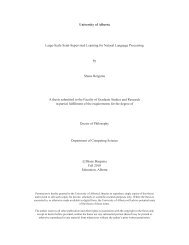The high altitude wildlife areas of western Arunachal Pradesh
The high altitude wildlife areas of western Arunachal Pradesh
The high altitude wildlife areas of western Arunachal Pradesh
Create successful ePaper yourself
Turn your PDF publications into a flip-book with our unique Google optimized e-Paper software.
Chapter 1<br />
<strong>The</strong> Buddhist Monpa, the main tribe <strong>of</strong> the <strong>high</strong> <strong>altitude</strong>s, are predominantly agropastoralists<br />
<strong>of</strong> the Indian Army in the district, given that it shares international boundaries with<br />
Bhutan and China.<br />
<strong>The</strong> larger (7422 km 2 ) West Kameng District has a lower human density (10<br />
per km 2 ) 11 , with the people belonging to 5 tribes: Monpa, Sherdukpen, Khowa, Aka,<br />
and Miji 32 . <strong>The</strong> region is drained by the Kameng or Bhareli and its tributaries<br />
(eventually joining the Brahmaputra), and is divided into six adiministrative circles<br />
(Bomdila, Dirang, Kalaktang, Bhalukpong, Nafra, and Thrizino).<br />
<strong>The</strong>se two districts together encompass a wide altitudinal gradient, with the<br />
Greater Himalayan Range and the state’s <strong>high</strong>est peaks (Kangto 7090 m, Gorichen<br />
6538 m) forming the northern boundary. People in the relatively low-lying valleys<br />
cultivate rice. Other crops include barley, wheat, millet, maize, buckwheat, etc.<br />
Livestock include yak, cattle, mithun, and their hybrids, in addition to sheep and<br />
horses. <strong>The</strong>y are used for wool, meat, and milk products such as butter and cheese<br />
which form the main source <strong>of</strong> income. Women weave rugs, carpets, clothes and bags<br />
from the locally produced wool. Some villages in the <strong>high</strong>er <strong>altitude</strong>s are<br />
predominantly pastoral, while most are agro-pastoral. Cultivation can be found up to<br />
3000 m. High <strong>altitude</strong> <strong>areas</strong> between 3500 m and 5200 m are used for summer grazing<br />
(especially by yak, sheep, and yak-cattle hybrids). Monpa are the predominant<br />
community inhabiting the <strong>high</strong>er <strong>altitude</strong>s. Towards the eastern limit <strong>of</strong> our survey<br />
region, the Miji <strong>of</strong> East Kameng sometimes hunt in the same <strong>high</strong> <strong>altitude</strong> <strong>areas</strong> that<br />
are used for livestock grazing and hunting by Monpa. As a result, there is a certain<br />
level <strong>of</strong> conflict between the two tribes over their hunting and grazing rights in the<br />
eastern part <strong>of</strong> West Kameng’s <strong>high</strong> <strong>altitude</strong>s.<br />
Methods<br />
Through existing terrain maps, we identified the entire <strong>high</strong> <strong>altitude</strong> <strong>areas</strong> (> 3000 m)<br />
in Tawang and West Kameng districts, and for convenience, divided them into six<br />
regions: Upper Nyamjang Chu Valley, Lower Nyamjang Chu Valley, Mago Chu<br />
Valley, Mukto, PTSO, and the <strong>high</strong> <strong>altitude</strong> <strong>areas</strong> <strong>of</strong> West Kameng (Fig. 2). All six<br />
<strong>areas</strong> were then surveyed between August and October 2003. We distributed our<br />
survey effort (in terms <strong>of</strong> the number <strong>of</strong> days) amongst these <strong>areas</strong> according to the<br />
available extent <strong>of</strong> <strong>high</strong> <strong>altitude</strong> habitat. In Upper Nyamjang Chu Valley, we were<br />
4

















